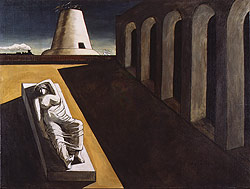
Later versions of the myths (part 2)
Richard Strauss composed this German opera within an opera, in which the "richest man in Vienna" hosts a great party and hires too many entertainers. As a result, the opera and the comedy act must take place simultaneously. Thus the prologue ends and the opera begins. Ariadne, accompanied by nymphs, laments her forlorn state of abandonment, and the comedians attempt to cheer her up to no avail. Ariadne decides to wait for Hermes to take her to the underworld. Still the comedians are having no success, and their leader tries to comfort her, but ends up insulting her. Finally one of the comedians breaks through Ariadne's defenses and hugs her. Then Bacchus arrives on a ship. Ariadne at first thinks he is death, then thinks maybe he is Theseus returning to her. Bacchus dispels these notions by introducing himself as a god. The two fall instantly in love, and Ariadne ascends into the heavens with Bacchus.
for additional analysis on Ariadne auf Naxos, click here
by: Becca Goldknopf
(We apologize for the lack of bibliographical information on this story. The source's site was unnavailable on Oct. 15. We will check it again soon to make sure it is up and running again.)
Ariadne, having been abandoned on Naxos by Theseus, screams at whatever god tortures her with thoughts of her unfaithful lover. She wants someone to love her still. She curses the unknown god for striking her but not killing her. She accuses him of "eavesdropping" on her heart and being "jealous" of her. She calls him many evil things and curses him. When she thinks he has gone, Ariadne realizes that the unknown god wants her, loves her, and that she loves him too. Finally, Dionysus reveals himself.
by: Becca Goldknopf
Giorgio de Chirico’s “Ariadne”
The painting entitled “Ariadne” by Giorgio de Chirico is part of a five painting series all of which were done in 1913, also all of the paintings feature the reclining statues of Ariadne. The painting “Ariadne” is done in the style of surrealism. Giorgio himself is recognized as one of the predecessors of this type of painting. The painting features a roman copy of a lost Hellenistic statue of Ariadne, who is asleep on the island of Naxos where Theseus abandoned her.
Painting by Giorgio de Chirico
Some of the common themes in Giorgio’s paintings include: the always deserted public squares, shadows, and the always slumbering statues of Ariadne. For further information on the art work of Giorgio de Chirico and how his art is related to the myth of Ariadne visit the website below:
http://www.studio-international.co.uk/painting/chirico.htm
for additional analysis on Giorgio's paintings, click here
by: Allie Coutts
The research paper “Ariadne” is written by Dr. Alena Trckove-Flamee Ph.D. In this research paper she discusses the different names that refer to Ariadne, she also discusses two different versions of the myth about Ariadne and Theseus. She also writes how there are different myths about how Ariadne was killed in the first one it is said that she was killed by Artemis during her childbirth, another version of that myth is that Artemis felt sorry for Ariadne because she was so depressed because Theseus left her. In the Homeric version of that myth it is said that Ariadne hangs herself from a tree because of Theseus.
The research paper also contains the analysis of the cult of Ariadne it also gives examples of the rituals that the cult members conducted during their worship ceremonies. Dr. Trckove-Flamee continues on to describe some works of art that contain the figure of Ariadne as a main figure in the art work, and how Ariadne influences art work.
by: Allie Coutts
How Bacchus Finds Ariadne Sleeping
Bacchus sees Ariadne sleeping and talks to his "Bacchantes" about her beauty. He compares her beauty to that of the gods: "She looked like Venus when the goddess smiled." (Page 220) Ariadne wishes that Bacchus had never waked her, because she was dreaming of being with Theseus. She comments on how, while she slept, Theseus left her.
How Bacchus Comforts Ariadne
Bacchus comforts Ariadne by lowering the appeal of Theseus. He does this by comparing himself (a god) with Theseus (a mortal). Bacchus tells Ariadne how much greater he is, and tells her all that she would have by being with him.
for additional analysis on these poems, click here
by: Andrew Moeller
*Greek and Roman versions of Ariadne (part 1)
Analysis of Ariadne and Theseus
Return to CLA 2-216A-2005 home page